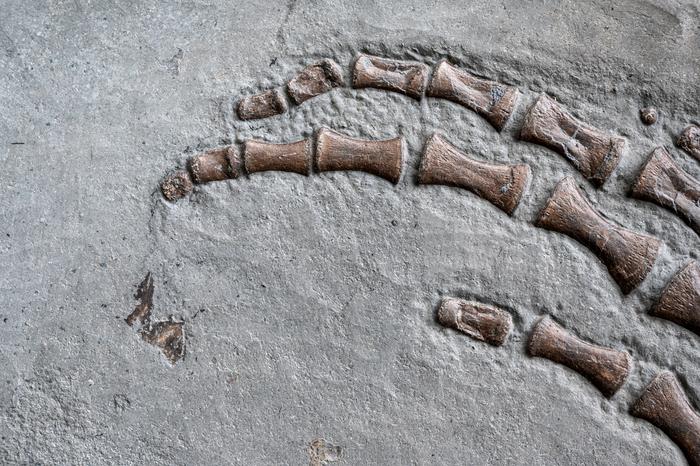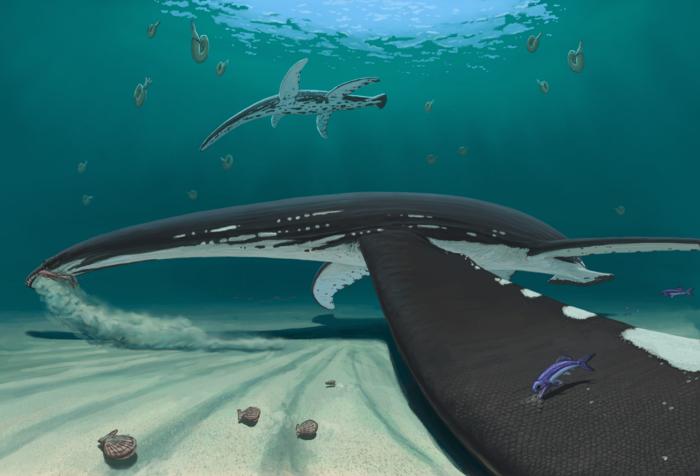A 183-million-year-old fossil with exceptionally well-preserved soft tissues has revealed that some plesiosaurs were covered in both skin and scales, suiting them to a life stalking the seas for prey.
ADVERTISEMENT GO AD FREE
The iconic marine monsters went extinct with the dinosaurs and have been discovered all over the world, but to find fossilized soft tissues alongside their skeletal remains is remarkably rare. This latest find – discovered among the Posidonia Shale of Germany and dating to the Lower Jurassic – is practically complete, a boon in itself, and features traces of skin around the tail and front flipper, making it the first in-depth study of plesiosaur soft tissues.
Pigment cells, including melanosomes and keratinocytes, were identified in the tail samples, alongside three layers of skin cells: the stratum corneum (the outermost layer of the epidermis), stratum spinosum (an intermediary layer), and stratum basale (the deepest layer).
Palaeontologists also found structures on the flippers reminiscent of modern reptilian scales, suggesting some of these ancient brutes had smooth skin on their bodies and tails, with small scales on their limbs. This, the researchers say, is surprising, given that other Mesozoic marine reptiles, including ichthyosaurs, were scaleless.

The tip of the right flipper with two scales along the trailing edge.
Image credit: Klaus Nilkens/Urwelt-Museum Hauff
“Fossilized soft tissue, such as skin and internal organs, is exceptionally rare. We used a broad range of techniques to identify smooth skin in the tail region as well as scales along the rear edge of the flippers. This provided us with unparalleled insights into the appearance and biology of these long-extinct reptiles,” Miguel Marx, a PhD student in geology at Lund University and the lead author of the study, said in a statement.
“Our findings help us create more accurate life reconstructions of plesiosaurs, something that has been extremely difficult since they were first studied over 200 years ago. Also, the well-preserved German fossil really highlights the potential for soft tissue in providing valuable insights into the biology of these long-extinct animals.”

Skin from the bottom half of the tail is visible as a beige, pitted surface.
Image credit: Klaus Nilkens/Urwelt-Museum Hauff
The mish-mash of skin and scales is fairly unusual, but may have served a useful purpose, tailoring plesiosaurs to swimming and hunting – benefitted by their hydrodynamic skin – and also traversing rough seafloor – aided by their scaly flippers. As a result, the prolific prehistoric predators were well adapted to terrorize their prey at all ocean depths.
ADVERTISEMENT GO AD FREE
By opening up a window into the past, incredible discoveries such as this can teach us invaluable lessons about the evolution of life on Earth – though some things, like skin, can appear strikingly unchanged despite eons of adaptations.

Scaly flippers and a smooth body likely helped the plesiosaur to hunt.
Image credit: Joschua Knüppe
“Apart from the mosaic of smooth skin and scales, it was an incredible moment to visualize the cells in thin sections of the fossilized plesiosaur’s skin. I was shocked when I saw skin cells that had been preserved for 183 million years. It was almost like looking at modern skin,” added Marx.
The study is published in Current Biology.
Source Link: "Exceptionally Rare" 183-Million-Year-Old Plesiosaur Was Covered In Mosaic Of Skin And Scales